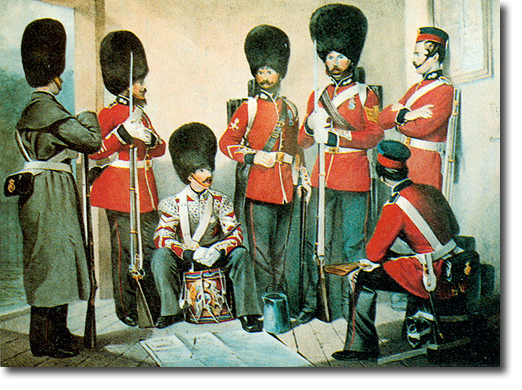|
|

 |
|
This lithograph was based on a photo of men of the Grenadier Guards of different types and different orders of dress. The tunic worn is the 1856 pattern with white button loops on the cuff and on the back of the skirts. It is a pity that the man sitting with his back to us does not show the buttons and loops on the back of his tunic skirt. He does have an ammunition pouch on a broad white belt which goes over his left shoulder as does the man on the left in a greatcoat. This style of carrying ammunition had been used since the 18th century and did not change until 1871 when ammunition was carried in pouches fixed to the front of the waistbelt.
The bearded man second from the left is holding his Enfield rifle with socket bayonet attached. We can just see good conduct stripes on his right sleeve. These were introduced in 1836 and were worn on the lower right arm until 1881 when they were moved to the left arm. Next to him is a corporal drummer. See Corps of Drums and Musicians On the other side of him is a pioneer with one good conduct stripe, holding an axe and displaying a Crimea medal. He has a dark leather strap on his left shoulder to carry a tool pouch. Next to him is a Colour-Sergeant with gold chevrons and Colour badge, also a Crimea veteran. His sergeants sash is supposed to be crimson. The two men on the right of the picture are remarkable for the fact that they wear the undress forage cap. The caps are blue with a red band, the distinction of the Grenadier Guards, and a brass grenade badge on the front. The shape of the upper part is slightly bell-topped and is quite high. Other ranks below the rank of sergeant had a peakless cap while ranks above this, including officers, had gold edged peaks. See Officer and Senior NCOs 1858 |
Armed Forces | Art and Culture | Articles | Biographies | Colonies | Discussion | Glossary | Home | Library | Links | Map Room | Sources and Media | Science and Technology | Search | Student Zone | Timelines | TV & Film | Wargames